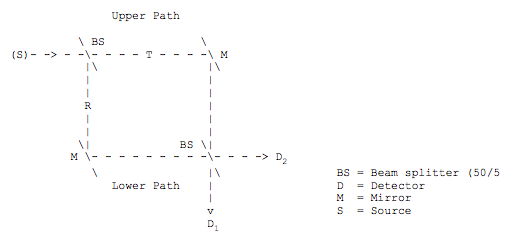7.2: Single-Photon Interference - Second Version
- Page ID
- 137792
Using Dirac Notation to Analyze Single Particle Interference
The schematic diagram below shows a Mach-Zehnder interferometer for photons. When the experiment is run so that there is only one photon in the apparatus at any time, the photon is always detected at D2 and never at D1. (1,2,3)
The quantum mechanical analysis of this striking phenomenon is outlined below. The photon leaves the source, S, and whether it takes the upper or lower path it interacts with a beam splitter, a mirror, and another beam splitter before reaching the detectors. At the beam splitters there is a 50% chance that the photon will be transmitted and a 50% chance that it will be reflected.

After the first beam splitter the photon is in an even linear superposition of being transmitted and reflected. Reflection involves a 90o (π/2) phase change which is represented by exp(iπ/2) = i, where i = (-1)1/2. (See the appendix for a simple justification of the 90o phase difference between transmission and reflection.) Thus the state after the first beam is given by equation 257.1.
\[ | \psi = \left( \frac{[ | T> + i|R ]}{2} \right) ^{ \frac{1}{2}} \nonumber \]
Now |T> and |R> will be written in terms of |D1> and |D2> the states they evolve to at detection. |T> reaches |D1> by transmission and |D2> by reflection.
\[ |T> = \left( \frac{[|D1> + i|D2>]}{2} \right) ^{ \frac{1}{2}} \nonumber \]
|R> reaches |D1> by reflection and |D2> by transmission.
\[ |R> = \left( \frac{[i|D1> + |D2>]}{2} \right) ^{ \frac{1}{2}} \nonumber \]
Equations 257.2 and 257.3 are substituted into equation 257.1.
\[ | \psi > = \frac{[|D1> + i|D2> + i2|D1> + i|D2>]}{2} \nonumber \]
It is clear (i2 = -1) that the first and third terms cancel (the amplitudes are 180o out of phase), so that we end up with a final state given by equation 257.5.
\[ | \psi> = i|D_2> \nonumber \] The probability of an event is the square of the absolute magnitude of the probability amplitude.
\[ P(D_2) = |i|^2 = 1 \nonumber \]
Thus this analysis is in agreement with the experimental outcome that no photons are ever detected at D1.
Appendix:
Suppose there is no phase difference between transmission and reflection. Then equations 257.1, 257.2, and 257.3 become
\[ | \psi = \left( \frac{[|T> + |R>]}{2} \right) ^{ \frac{1}{2}} \nonumber \]
\[ | T> = \left( \frac{[|D1> + |D2>]}{2} \right) ^{ \frac{1}{2}} \nonumber \]
\[ | \psi = \left( \frac{[|D_1> + |D_2> |D_1> + D_2>]}{2} \right) ^{ \frac{1}{2}} \nonumber \]
Substitution of equations 257.8 and 257.9 into equation 257.7 yields
\[ | \psi > = |D_1> + |D_2> \nonumber \]
Thus, the detection probabilities at the two detectors are:
\[ P(D_1) = 1 and P(D_2) = 1 \nonumber \]
This result violates the principle of conservation of energy because the original photon has a probability of 1 of being detected at D1 and also a probability of 1 of being detected at D2. In other words, the number of photons has doubled. Thus, there must be a phase difference between transmission and reflection, and a 90o phase difference, as shown above, conserves energy.
References:
1. P. Grangier, G. Roger, and A. Aspect, "Experimental Evidence for Photon Anticorrelation Effects on a Beam Splitter: A New Light on Single Interferences," Europhys. Lett. 1, 173-179 (1986).
2. V. Scarani and A. Suarez, "Introducing Quantum Mechanics: One-particle Interferences," Am. J. Phys. 66, 718-721 (1998).
3. Kwiat, P, Weinfurter, H., and Zeilinger, A, "Quantum Seeing in the Dark, Sci. Amer. Nov. 1996, pp 72-78.

